Homemade Tahini Recipe
This post may contain affiliate links. See my disclosure policy.
This easy homemade tahini recipe is so quick to make, takes just TWO ingredients, is less expensive than store-bought, and tastes WAY better! Make a double batch while you’re at it and store it in your fridge for several months to have on hand whenever you need it!
Use it make the best creamy Hummus Recipe or drizzle it over your homemade Falafel!
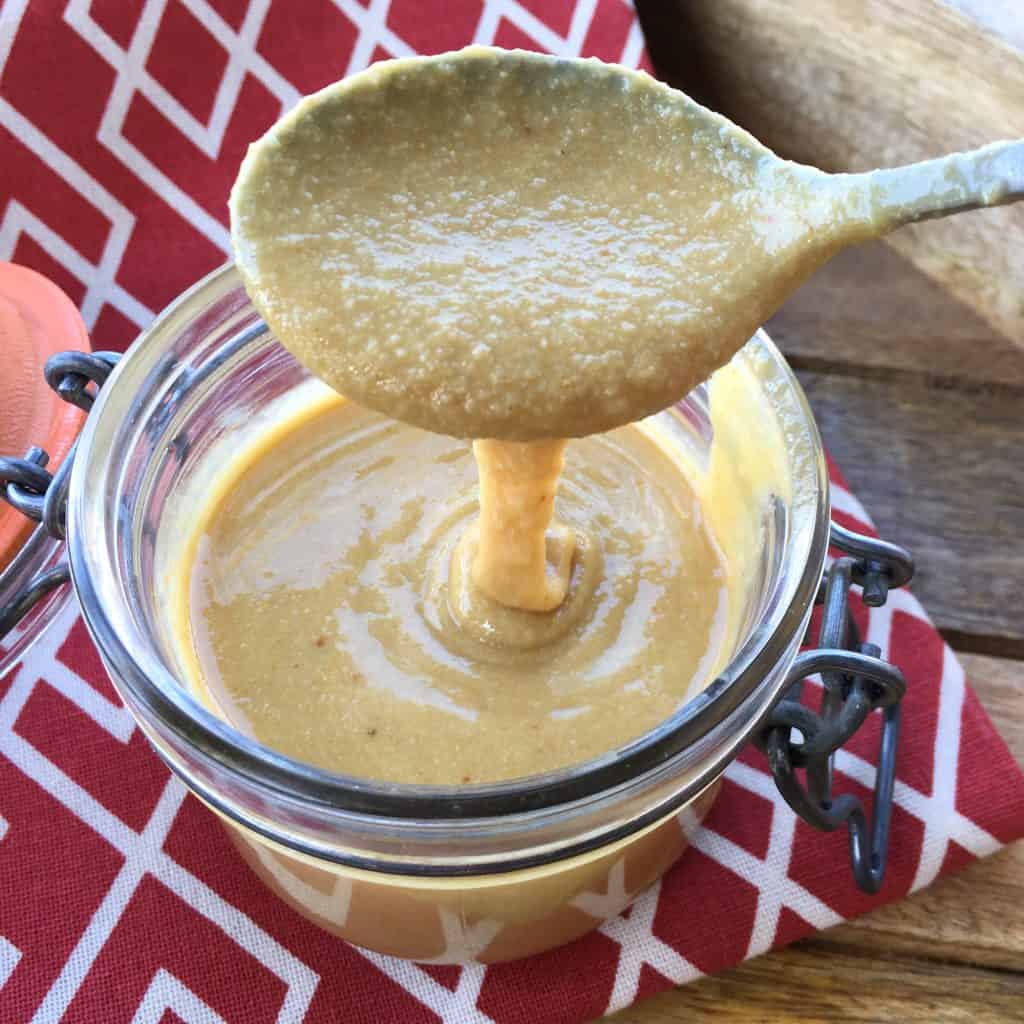
The scenario you may be familiar with: You’re really in the mood for some homemade hummus. Garbanzo beans? Check. Olive oil? Check. Lemons? Check. Garlic? Check. Tahini paste? Aw, dang it. Well don’t let that stop you again. Tahini is not only super simple to make, but homemade is cheaper than store-bought and it tastes better!
What is Tahini?
Tahini is a Middle Eastern condiment that is made from hulled sesame seeds that are toasted and then ground into a paste. It’s a popular staple in Middle Eastern, Greek, and East Asian cooking. It is served by itself as a condiment but also incorporated into a very wide variety of dishes, most famously a central ingredient in hummus.
Tahini Ingredients
To make tahini you only need two ingredients:
- Sesame seeds
- Olive Oil
You may be asking, “why do you need olive oil for tahini?” and that’s a good question because if you look at the ingredients of most commercially-sold tahini, it does not include olive oil. But there’s a good reason why homemade tahini needs the addition of olive oil and that’s because the oil from the sesame seeds cannot be fully extracted without specialized commercial equipment. If you put a bunch of sesame seeds in a regular blender you will get a heap dry ground sesame seeds. Another factor has to do with the freshness of the sesame seeds (the fresher the more oil) and unfortunately most of the sesame seeds available at the store have been sitting there, and in warehouses before that, for a long time. And so we add olive oil.
Shopping Tip: Buy sesame seeds in bulk. Buying the in tiny bags or cans with just a few ounces is expensive and they’re a better deal in bulk. You can buy sesame seeds in the bulk sections of some grocery stores or you can buy them online such as here.
Pro Tips
- Use hulled sesame seeds. Hulled sesame seeds have had their hard outer shell removed which 1) makes the tahini smoother and 2) less bitter tasting.
- Be careful toasting the sesame seeds. As soon as the sesame seeds start changing color watch very closely because they can scorch quickly which will make them bitter. Toast just until they’re golden.
- Use a high quality olive oil.
- Use a high-powered food processor or blender. A food processor like my mini-prep Cuisinart food processor (we’ve had ours for 17 years and it’s still going strong) does a good job and is ideal for smaller quantities like this but for a smoother tahini paste you can use a high-powered blender such as my Vitamix 5200 (we’ve been using it on average twice a day, every day, for the last 15 years and it’s a total workhorse).
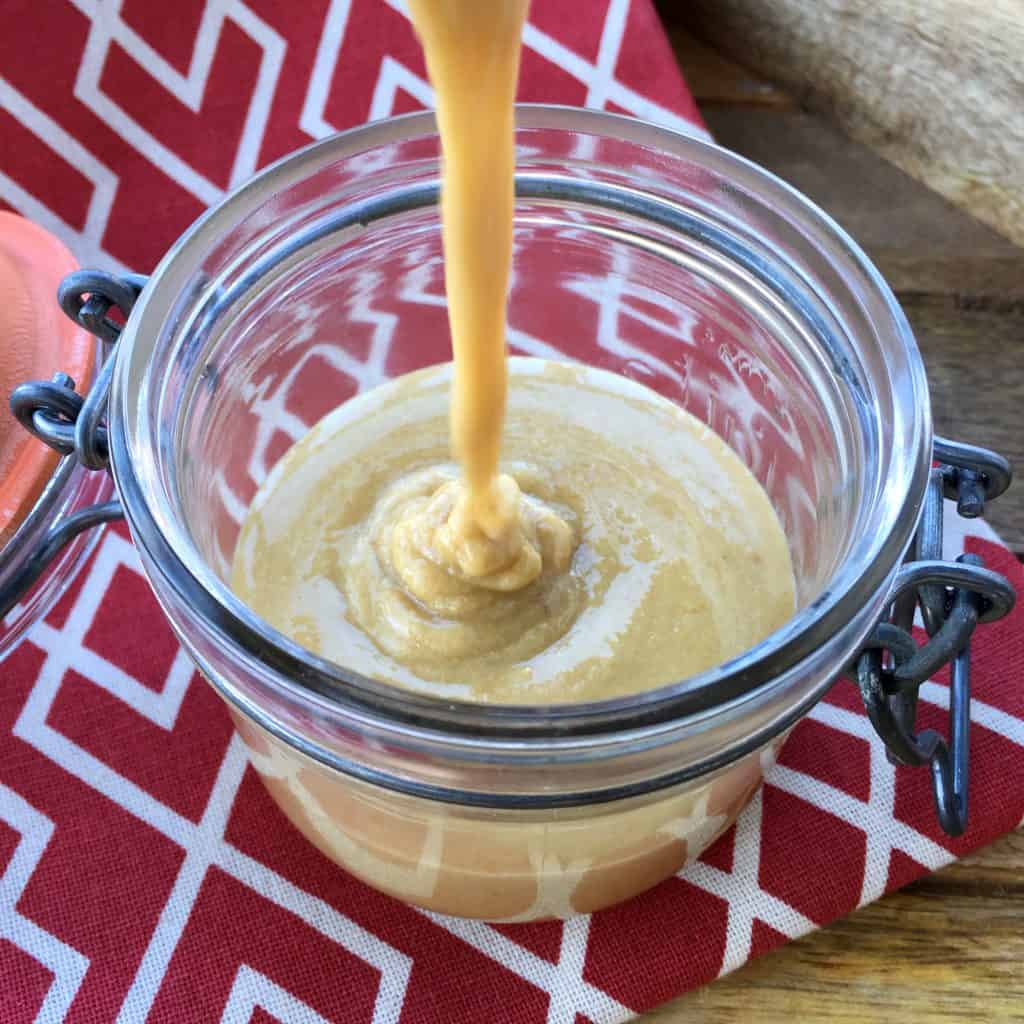
Tahini Recipe
This tahini recipe uses one cup of sesame seeds which will make about 3/4 cup tahini paste, depending on how much olive oil you use. How much olive oil you use will depend on how thick you want the paste. You’ll need at least 3 tablespoons of olive oil and possibly up to 1/3 cup. Note: If you’re using a high-powered blender like a Vitamix, you may need less oil than if you’re using a food processor.
Let’s get started!
Heat a clean, dry cast iron or heavy duty skillet over medium high heat and add the sesame seeds. Stir frequently until they begin to turn golden brown and then stir constantly. Be careful, sesame seeds burn very easily.
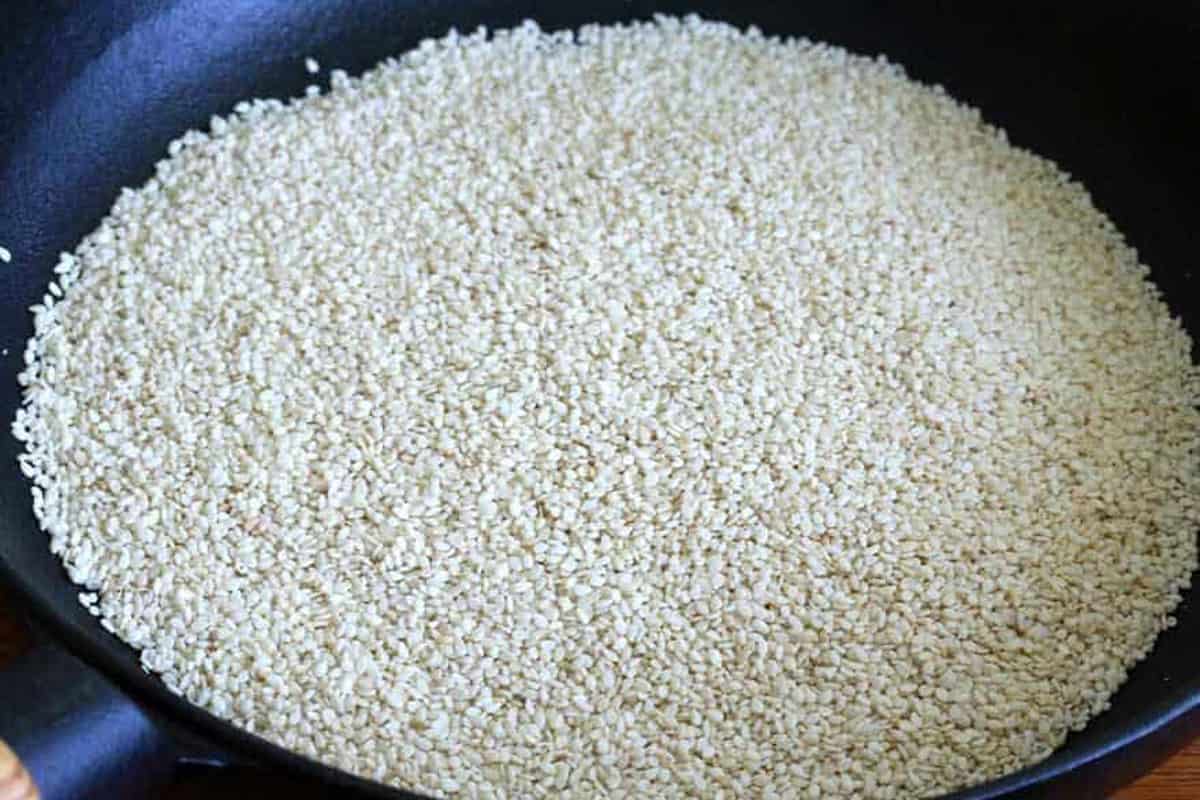
You definitely don’t want burnt sesame seeds (they taste awful!), but you do want them generously golden brown for optimal flavor.
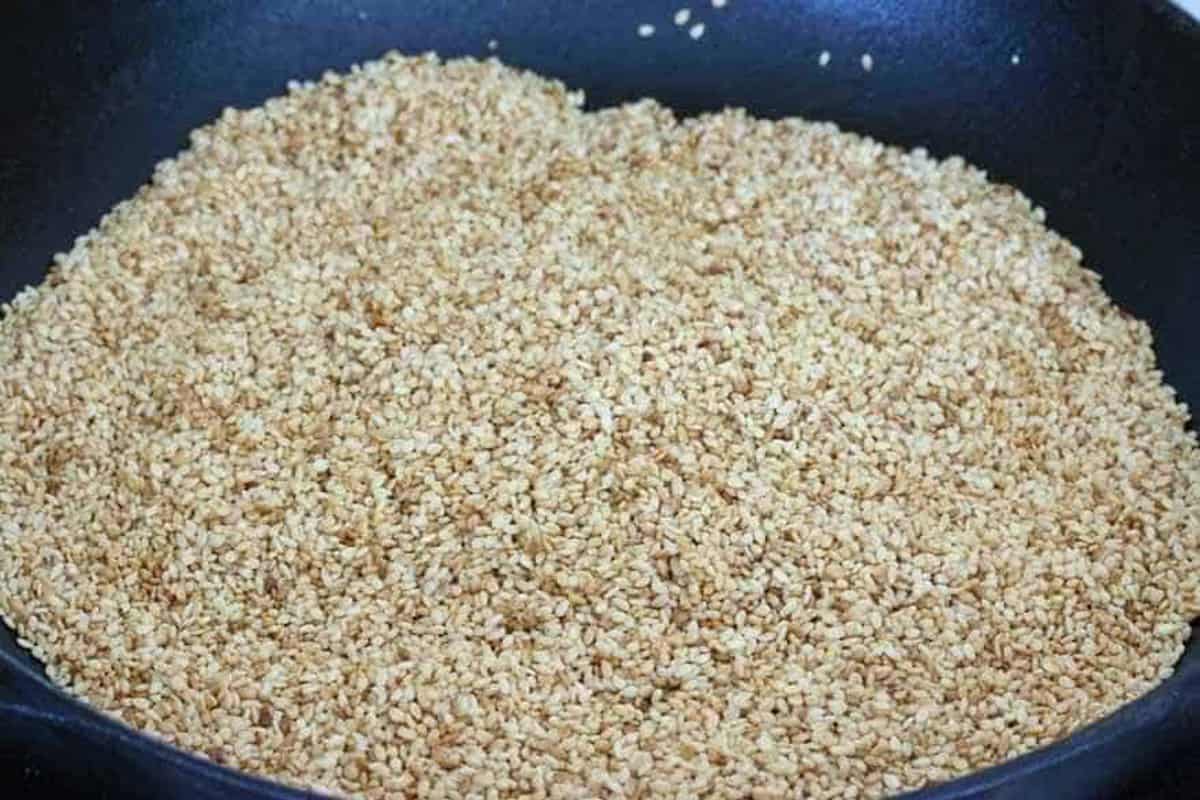
Once they’re toasted, let them cool a few minutes then add them to a food processor. I use and love Cuisinart’s mini prep food processor. With a 3-cup capacity it’s perfect for smaller jobs like this. We’ve had ours for over 15 years and it’s still going strong!
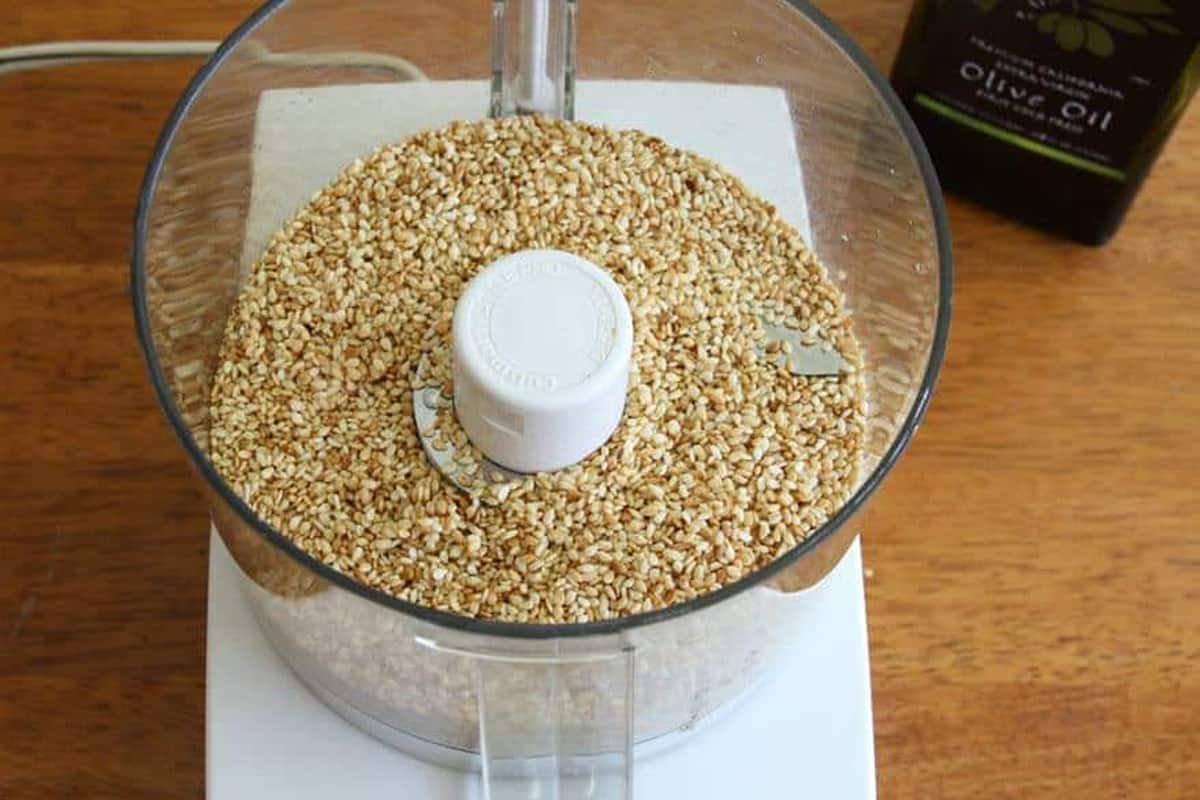
Start by adding 3 tablespoons of olive oil. Process the mixture into a paste, scraping down the sides. Add more olive oil until you reach the desired consistency. If you’re using it to make hummus, the paste should be fairly thickly “pourable” (like in the main recipe picture above).
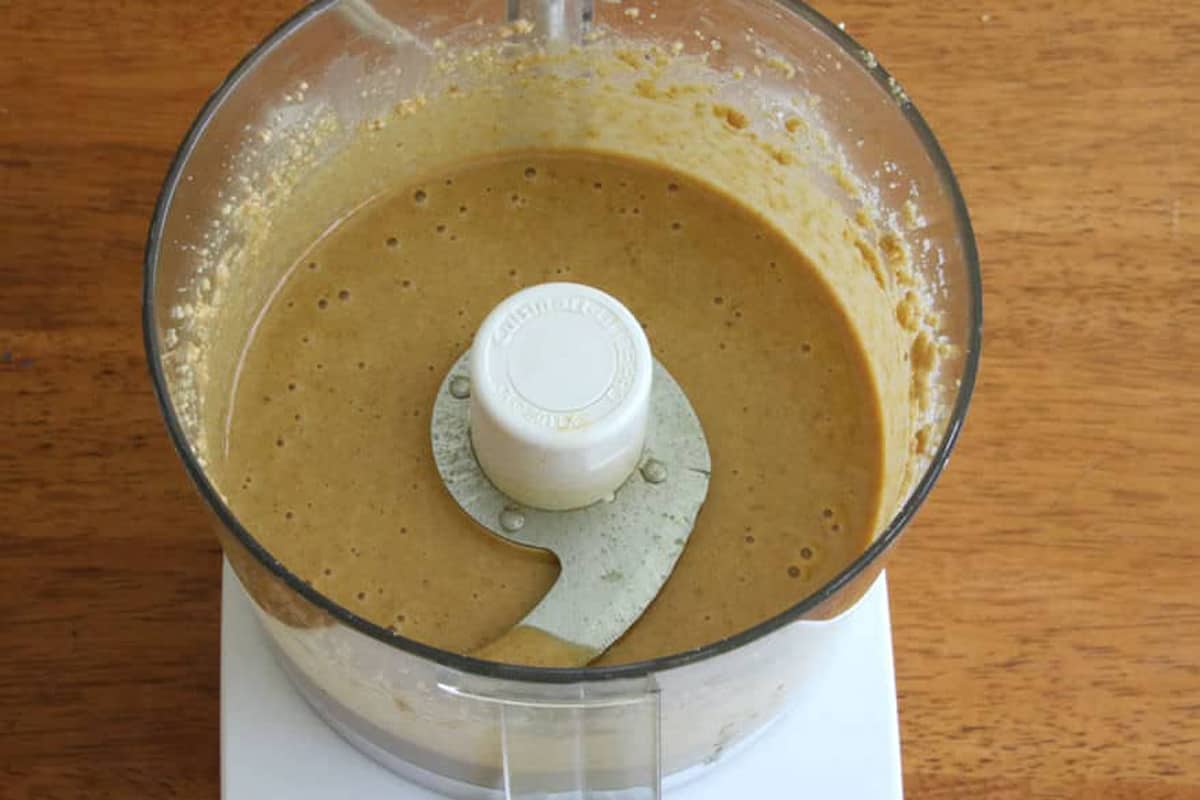
Storage & Freezing
Stored in the fridge in an airtight jar, tahini will keep for 1-2 months; potentially longer but for optimal freshness use it within that time frame. The oil will separate during storage, which is completely normal. Just give it a good stir before using.
Tahini can also be frozen for up to 3-4 months. You can freeze it in its jar, leaving some headspace because it may expand a little. For convenient smaller portions you can also divide it up in ice cube trays, freeze it, then put the frozen cubes in a freezer bag or container, and just take out what you need. Either way, let the tahini thaw slowly, ideally in the fridge overnight.
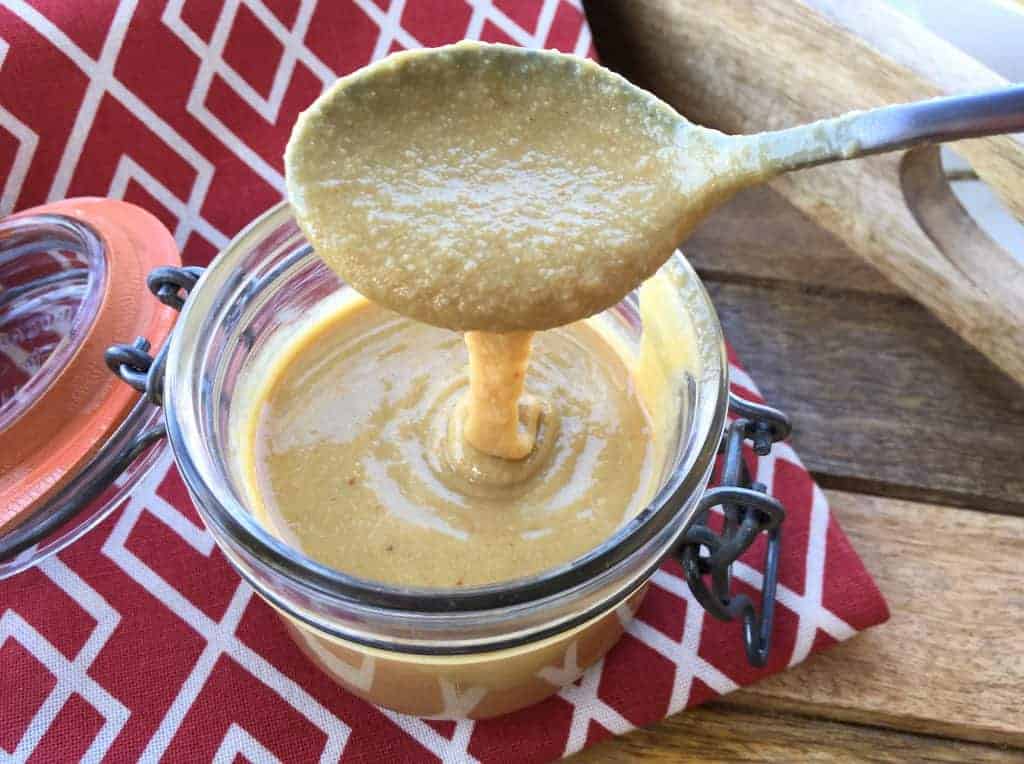
How To Use Taxhini
There are a number of delicious ways you can put your homemade to use. Here are just a few ideas:
- Hummus – its most popular use, check out our phenomenal Hummus Recipe.
- Baba Ganoush – like hummus, it’s wonderfully creamy and the tahini is a central star of the show.
- Tahin Pekmez – a popular dip in Turkey. It has the reputation as being the Turkish PBJ because it’s made with tahini (which has kind of a peanut-buttery taste) and grape molasses. Sound like a winning combination? It is!
- In Greece it’s a popular condiment in which to dip pita and souvlaki (grilled meat kabobs).
- In Israel it’s a staple topping for Falafel and shawarma. It’s also used to make halva-like treats.
- In East Asia it’s commonly used in noodle dishes.
- Throughout the Middle East it is used in sauces for meats and vegetables to enhance the flavor.
- It makes a really nice tahini salad dressing combined with lemon juice, olive oil, honey or maple syrup, garlic and salt.
- Drizzle it over your sandwiches, wraps, and lettuce wraps.
- Drizzle it over grilled meats and vegetables. It’s amazing on our Grilled Eggplant!
- Add it to your baked goods like cookies for a delicious twist!
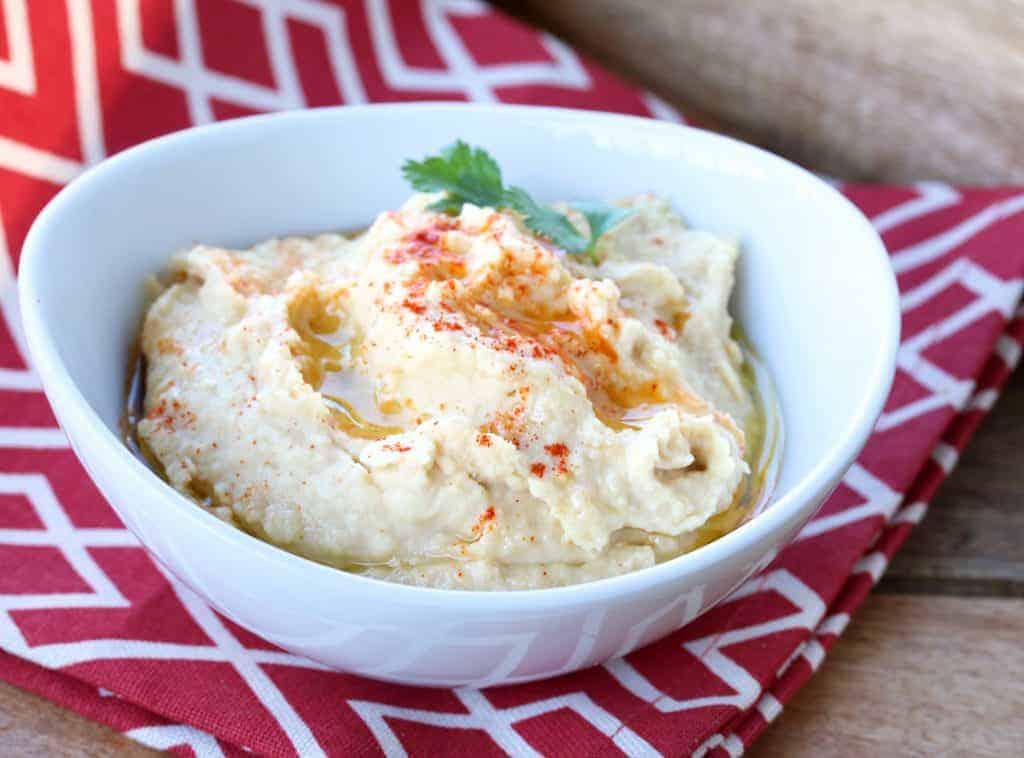
For more delicious homemade condiments try my:
- Tartar Sauce
- Yum Yum Sauce
- Bearnaise Sauce
- Black Bean Sauce
- Hoisin Sauce
- Big Mac Sauce
- Jerk Sauce
- Adobo Sauce
- Mignonette Sauce
- Aji Verde
- Enchilada Sauce
- Homemade Ketchup
- Ponzu Sauce
- Char Siu Sauce
- Romesco Sauce
- Eel Sauce
- Sweet Chili Sauce
- Remoulade
- Teriyaki Sauce
- Sweet and Sour Sauce
Save This Recipe
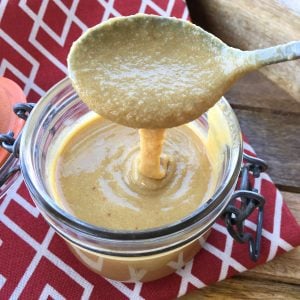
Homemade Tahini Recipe
Ingredients
- 1 cup hulled sesame seeds
- 3 tablespoons or more extra virgin olive oil ,see Note (see also blog post about why olive oil is added)
Instructions
- Heat a clean, dry cast iron or heavy duty skillet over medium high heat and add the sesame seeds. Stir frequently until they begin to turn golden brown and then stir constantly. Be careful, sesame seeds burn very easily.
- Once they're toasted, let them cool a few minutes then add them to a food processor. Start by adding 3 tablespoons of olive oil. Process the mixture into a paste, scraping down the sides. Add more olive oil until you reach the desired consistency (*see Note)
- Store the tahini in an airtight jar in the fridge and it will last for several months. Stir it throughly before you put it in the fridge because once it's chilled it's difficult to stir. This makes a little less than 3/4 cup tahini paste, depending on how much olive oil you use.
Notes
Nutrition
Originally published on The Daring Gourmet May 2017



















When toasting my sesame seeds I think I may have let them get too dark? The paste tastes sort of bitter (and I’m not sure if it’s a normal tahini flavour or literally a “burnt” taste). I stirred and stirred the seeds in the pan but had trouble getting them to all brown evenly. Would I have been better to quit while some were still very pale in order to keep others from getting too dark brown? And is dark brown pretty much “burnt” when it comes to sesame seeds?
Hi Carol, yes, dark brown is burnt. But the paste is going to taste somewhat bitter anyway (ie, it doesn’t taste good on its own, only when it’s mixed in something). Yes, with the next batch you’ll want to quit toasting them sooner, even if not all of them are light brown (that’s okay). It takes a little getting used to – sesame seeds take a little while to start changing color but once they do they go really fast!
Amen I did mine on top of stove in a fry pan, some got pretty dark, but it turned out good anyway..some of mine were dark, but not the majority. But I thought it was too strong for my taste to start with so after adding chick peas, it was milder and yummy…
Thanks, Jalane! Yes, by itself it’s very strong. It’s a condiment that’s meant to be added to other foods – then it tastes amazing!
OMG. I meant the hummus was too strong… I made the black bean kind and it was too spicy for me and my husband. so I ground up another can of chick peas, and added it to my hummus. . Then last night I added a TBL. of tahini to 1/4. C. of hummus and it was great as well. I used piita chips then some Trisksit. crackers. But my husband says the grands use fresh bell peppers, carrots, celery, cucumbers, any fresh veggies, and dip to their hearts content.
With so many children I try to have fresh fruit and veggies when they visit..
Can you put the sesame seeds in with the chickpeas and process them all together at the same time to make the hummus?
Hi Kendra, good question! The tahini is super duper concentrated and I don’t think you’d get the same amount of flavor by adding sesame seeds to the chickpeas. Plus, I think the biggest problem would be texture – it would be more difficult to get a smooth consistency if you’re not processing it separately. My fear is it would be really gritty. If you try it though, let us know how it goes!
agreed
Yes. Made it. Terrific. Made Hummus with it with Ina’s recipe.
Awesome, glad you liked the tahini, Sherri! Nothing beats the flavor of homemade, the flavor is so robust!
This is going to sound sacrilegious but if you are on a crazy tight budget and cannot afford Olive oil and the stupid stores won’t bring the 1L bottles down to 4$ so its in your budget. You CAN use canola oil to make it. Olive oil is much healthier and gives it a nice flavour but don’t let your budget keep you down. I made it this way and made Hummus from scratch with it(Including using dry chickpees and cooking them in the slow cooker) and it came out delicious.
Hi Camille, thanks for your input! You know though, I’ve see lots of brands of olive oil that are no more expensive than canola oil. I always marvel how expensive canola oil is such awful, awful stuff.
Hi! Is there a difference between using white sesame seeds and black sesame seeds?
You can use either, but the black will obviously dramatically change the color of the tahini and whatever else you’re using it in. I have not tried it with black sesame seeds and so I can’t vouch for any flavor differences. But white sesame seeds are what are most commonly used for tahini.
I’m soo going to make this…been looking for Tahini paste all day.
Awesome, spicycook! Let us know how it goes!
how long will the tahini paste last? Would it need to be refrigerated?
It will keep for several months – refrigerated is best to prevent it from going rancid.
Hi, how long should it take to process the sesame seeds in a food processor? I’m using a really good Cuisinart but it’s taking so long and I haven’t even reached a slightly runny consistency yet. In fact it’s still very thick and slightly grainy. I have added more oil but i’ve been going for over 10 mins now processing! Should it take longer or do i just need to keep adding more oil? Many thanks :)
Hi Andrea, yes, it sounds like you just need a little more oil. How fresh the sesame seeds are can impact how much oil is needed – the fresher the seeds the more natural oils will still be in them. Some stores carry seeds that have been sitting on the shelves or in warehouses for a long time and their natural oils dry out over time.